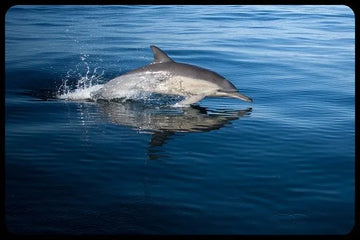If you want to show your love for dolphins and the ocean, don't miss our collection of dolphin T-shirts and sweatshirts. A highly original gift for those who love these mammals. Top-quality and worldwide shipping available.
We can find dolphins all over the world, especially in the shallow seas of the continental shelves.
DOLPHIN MORPHOLOGY
Dolphins have a streamlined fusiform body adapted for swimming at high speeds thanks to the powerful muscles of their tail fin. Meanwhile, the pectoral fins, along with the tail section, provide directional control and the dorsal fin, in those species who have it, provides stability.
Although it varies by species, their basic color patterns are shades of gray, usually with a lighter ventral area, and often have lines and spots which contrast with the main color.

The head of the dolphins contains a round organ, called melon, used for echolocation.
In many species their elongated jaws form a distinct beak, like in the case of the bottlenose dolphin (Tursiops truncatus) which simulates a smile with its curved mouth. The mouth of some species of dolphins can have up to 250 teeth. The dolphin brain is large and has a highly complex structure different from most of the land mammals and is considered one of the most intelligent animals on Earth.
Most dolphins have a highly developed vision, both in and out of the water, and they can hear frequencies ten times or more above the upper limit of adult human hearing. The dolphin’s sense of touch is also well developed, with dense nerve endings in the skin, especially around the snout, pectoral fins and genital area.
But dolphins lack of an olfactory nerve and are believed to have no sense of smell, but have a sense of taste and show preferences for certain types of food.
DOLPHIN BEHAVIOR
Dolphins are capable of performing a wide range of sounds using their nasal air sacs located just below the blowhole. Roughly there are three categories of sounds that dolphins can make: whistles, frequency modulated sounds and clicks. Dolphins communicate with sounds produced by the vibration of the connective tissue, similar to humans use the vocal cords. The clicks are directional sounds and used for echolocation, increasing the frequency of these clicks when approaching an object of interest.

Dolphins occasionally leap above the water surface and sometimes perform acrobatic figures. Although no one knows for sure the purpose of these stunts, they are believed to be used to better locate the fish schools since these jumps can help them to see groups of birds swooping to by those banks. Other possible reasons for these jumps can be communicating with other dolphins, parasite cleansing or just for fun.

Dolphins are social animals that live in groups of up to a dozen individuals but in places with a high abundance of food this groups merge temporarily and can exceed 1,000 dolphins. Individuals in these groups communicate using a variety of sounds such as clicks, whistles and other vocalizations.
Dolphins have curious social behaviors that show their great intelligence. For example, dolphins have been seen caring for other injured or sick dolphins and even helping them emerge to breathe. This altruism does not appear to be limited to their own species as there is an special case, a bottlenose dolphin called Moko from New Zealand, that guided a female Pygmy Sperm Whale (Kogia breviceps) together with her calf who beached and even they have been seen protecting swimmers from sharks by swimming in circles around them.
FEEDING
Dolphins are carnivores, and their main source of food is fish and squid but the killer whale and the false killer whale (Pseudorca crassidens) feed on other marine mammals too.
A common method of hunting they use is done in groups, gathering a school of fish where dolphins take turns to capture single specimens. In some parts of the world, common dolphins feed at night looking for species that rise to the surface during that time of day. Common dolphins are real specialists working together to get schools of fish close making them easier to be caught.
During the annual migration of the sardines from Cape Town in South Africa and along the coast to the north (called The Sardine Run) millions of these small fish feed on plankton and that is when the dolphins coordinate, working together to feed on thousands of sardines. This feast is also joined by sharks, whales and even birds.
DOLPHINS THREATS
The dolphins have few natural predators. The smaller species of dolphins are attacked by just a few of the larger sharks, such as the bull shark, the tiger shark and the great white shark, especially looking for the calves. Some of the larger species such as killer whales also eat small dolphins, but it is certainly rare.
The main threat to dolphins comes from humans, especially some river dolphin species such as the Amazon River Dolphin (Inia geoffrensis) or the Ganges River Dolphin (Platanista gangetica) that are in danger of extinction. Pesticides, heavy metals, plastics and other industrial and agricultural pollutants are poisoning many species of dolphins. Injuries and deaths from collisions with boats, especially with the propellers, are also common.

Different fishing techniques and drift nets directly kill many dolphins and bycatch poses a risk for many populations. In some parts of the world, such as Taiji in Japan and the Faroe Islands, dolphins are traditionally considered a source of food and are hunted for their meat.
Other human interference in the lives of dolphins are loud noises such as sonar or underwater construction projects like offshore wind farms which are harmful to dolphins by promoting decompression sickness because they force them to get to the surface too quickly to escape the noises.





















